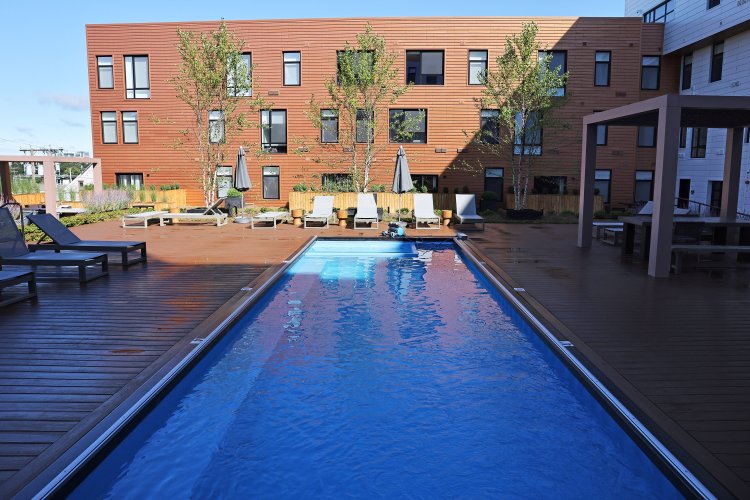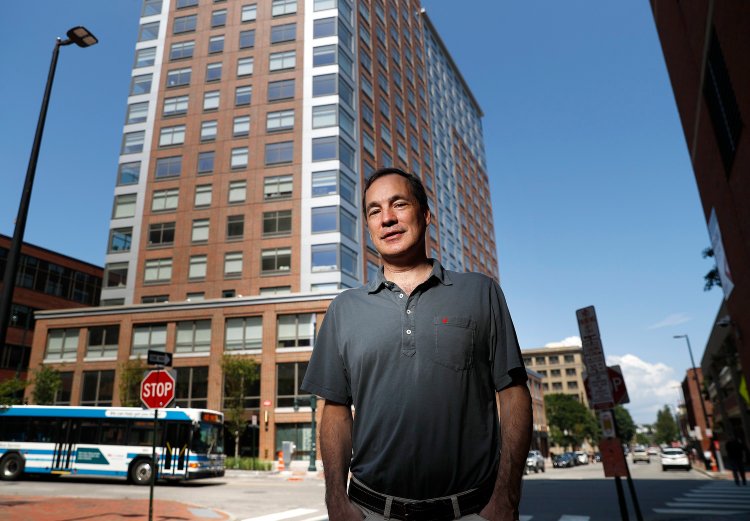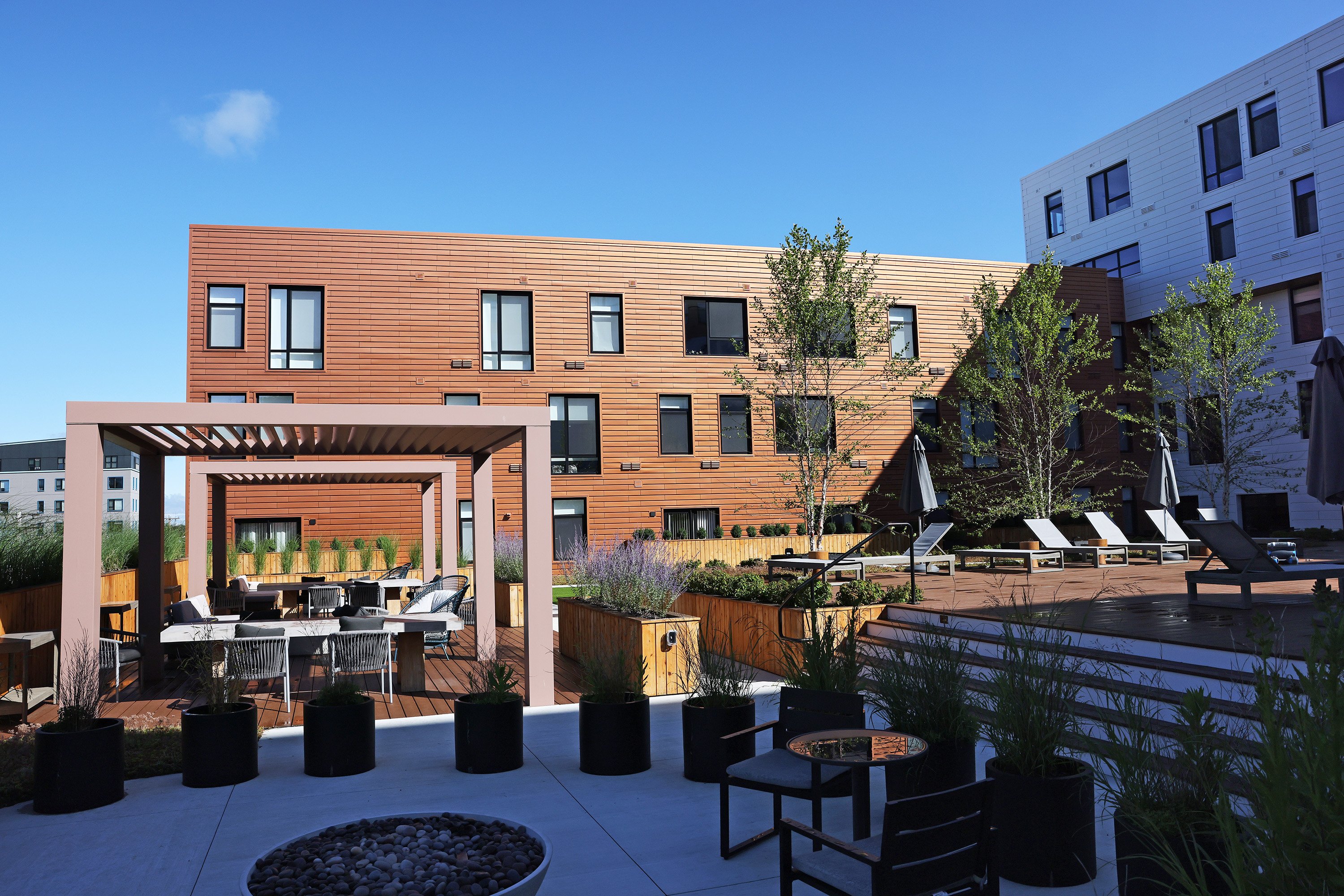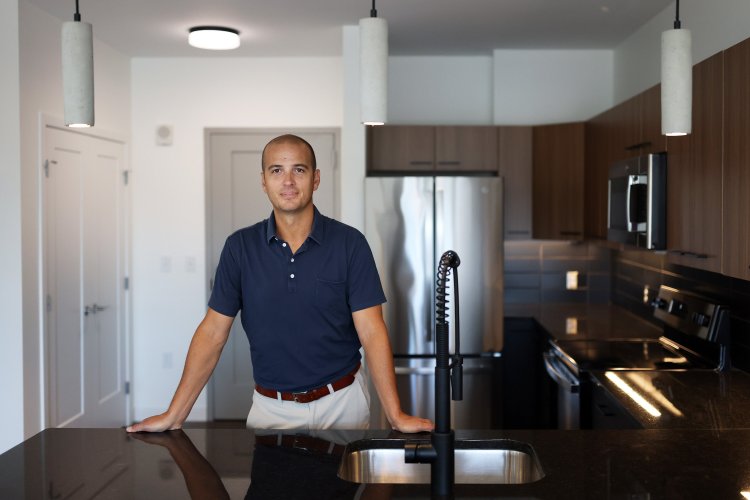

John Laliberte, CEO and developer for Reveler, ascends the staircase in the main lobby of The Armature, a newly opened luxury apartment building in Portland. Ben McCanna/Staff Photographer
This is the second in an ongoing series exploring the state’s housing crisis.
At one of Portland’s newest apartment buildings, residents can swim in a “resort-style” rooftop pool, play games in an “arcade lounge,” record a podcast in a mini-studio and bathe their dog at a grooming station. The 171 apartments have 9-foot ceilings, granite countertops and doors that open with the tap of a phone. Monthly rent for a two-bedroom hovers around $3,500, 40% higher than the average in Portland for an apartment of that size – $2,500 – and even further above the area’s fair market rent of $2,011.


The Armature, on Hanover Street, is the kind of building that raises eyebrows and draws criticism for being a playground for the wealthy and catering to out-of-staters while Portland and Maine grapple with a housing crisis.
Developers have long argued that all housing is good – that as the supply of homes grows, prices tend to fall.
There are “supply skeptics” or “housing truthers” who say the claim doesn’t pass the straight-face test. How could a gleaming high-rise filled with business executives and their designer dogs realistically have any impact on a single parent living in subsidized housing?
But evidence from researchers, economists, city officials and affordable housing advocates suggests there’s truth to the theory.
More housing – even luxury apartments – not only decreases overall rents and home prices in a city, it can also free up lower-cost units. It’s already happening in parts of the South that are bullish on development.


A rooftop courtyard at The Armature, a newly opened luxury apartment building in Portland, features a pool. Ben McCanna/Staff Photographer
Experts say it could happen in Portland, too, which is coming off a record-breaking year of development approvals, but it’s difficult to track and will take time to see any real impact.
Developers, however, also say they’re hampered by Portland’s regulations, which they say are too restrictive, and the cost of building materials and labor, which they say is prohibitive.
But even if they’re right and all housing is good, erecting a bunch of luxury apartment complexes isn’t going to be enough on its own to solve the housing crisis.
A HARD PILL TO SWALLOW
So if economists, affordable housing advocates, developers and city officials agree that all housing is good, why the skepticism?
“People see housing go up. They see cranes, they see construction. At the same time, they see rents going up or housing prices going up,” said Vicki Been, who recently co-authored a study on the topic. “They say, ‘I see supply, but I don’t see prices getting lower.’”
It’s a nuanced issue, said Been, the faculty director of New York University’s Furman Center for Real Estate and Urban Policy. There are many reasons – a global pandemic, for example – that might cause prices to swing, and it could take years to understand why.
New apartments don’t become occupied overnight, said Greg Watson, Portland’s housing and economic development director. “They don’t instantly take the pressure off of what may have been a few years of a lack of additional housing being developed,” he said.


Sydney Littlefield, who has lived in The Armature, a luxury apartment building in Portland, since it opened in November, works on her laptop within a shared space in the building. Ben McCanna/Staff Photographer
And in the time between groundbreaking and move-in, an area’s rent may have increased. “But (people are) pegging their beliefs on that brand new, high-end apartment,” Been said.
Been also said that by questioning new development, people can mask other reasons they may not want more housing in their neighborhood – classism, racism, resistance to change or the desire to avoid competition.
It is difficult to quantify the impact of more housing in Maine.
Unlike bigger states with major cities, Maine has many mom-and-pop landlords. It lacks the large-scale management companies and owners that track and publish property data for the marketplace. Plus, new housing tends to be added to neighborhoods that are already desirable or considered “up and coming.” It can be challenging to separate the impact of new apartments from other factors that might make housing more expensive, like new restaurants or shops. It can be a “chicken or the egg” scenario.
WHAT THE RESEARCH SAYS
Economist Evan Mast studied this idea of “supply skepticism” at the W.E. Upjohn Institute for Employment Research, a nonprofit research organization in Michigan.
He looked into the concept of filtering: that building high-end housing can cause a chain reaction of moves that ultimately frees up housing in lower-income neighborhoods.
Mast tracked the previous locations of 52,000 residents of hundreds of new market-rate buildings in the wealthier parts of several large cities, including Boston, Philadelphia and New York City. He studied the residents’ previous address, the current residents of those addresses, and so on.
In the first round, Mast found that people had largely moved from similarly high-income neighborhoods, but by the sixth round of moves, nearly 40% of the units people had moved out of were in below-median-income neighborhoods.
Mast determined that a new market-rate building that houses 100 residents ultimately leads 45 to 70 people to move out of lower-income neighborhoods, with most of the effect occurring within three years.
“These results suggest that the migration ripple effects of new housing will affect a wide spectrum of neighborhoods and loosen the low-income housing market,” Mast wrote.


A shared space at The Armature, a newly opened luxury apartment building in Portland, features an arcade where the game play is free. Ben McCanna/Staff Photographer
In another paper, Mast found that while rent in certain cities kept increasing each year, the increases came at a slower pace in poorer neighborhoods after market-rate apartments were built nearby.
NYU researcher Xiado Li found that for every 10% increase in the housing stock, rents decrease 1% and sales prices also decrease within 500 feet.
“Opposing such development may exacerbate the housing affordability crisis and increase housing cost burdens for local renters,” Li concluded in the 2019 study.
Across the Atlantic, European researchers are also studying the impact of new housing. A Finnish government agency found that while housing built in expensive areas of the country’s capital primarily housed wealthier people, the moving chains quickly reached middle- and low-income neighborhoods.
For every 200 new apartments, roughly 31 units in the bottom half of the neighborhood income distribution opened up.
And a German researcher found in 2020 that increasing new supply by 1% on average lowered rents in German cities by 0.2%.
While the studies support the idea that market-rate units will benefit the cost and availability of housing across the board, the researchers all agreed that a city cannot solely rely on the private market to solve the problem. Some people simply don’t make enough money.
MORE SUPPLY IS COMING
Last year was a banner year for development in Portland.
The city approved 1,283 new units and saw an additional 570 hit the market. It’s the most new housing the city has seen at either end of the approval process, since at least 2010.
Of the new units, 44% were considered affordable or workforce.
With affordable housing, a household pays no more than 30% of its gross income on housing costs, including utilities. Typically, people must make less than 80% of the area median income to be eligible for these units.
Workforce housing, on the other hand, means housing affordable to a person earning a little more – generally up to 120% of the area median income.
Market-rate housing is priced based on what rents the market will absorb without any subsidies or government assistance, while “luxury” is largely a marketing term to attract people seeking high-end finishes and extensive amenities.


Jonathan Culley, managing partner of Redfern Properties, at The Casco, an 18-story apartment building in Portland. Redfern has built more than 500 apartments in the area over the last year. Sixty of them are considered workforce housing. Derek Davis/Staff Photographer
Kevin Kraft, Portland’s planning director, said the city is ultimately happy for any housing.
“It’s a really nuanced problem to have as a city, as you really need a delicate balance,” he said.
He hopes that once more of the planned projects are complete, it will be easier to see whether Portland has struck that balance.
Victoria Morales, executive director of the Quality Housing Coalition, said she’s already seeing the impacts. The coalition was created to help people in need find safe, affordable housing and recently, it’s been a bit easier. “The market is softening a little teeny bit,” she said.
But how long that will last remains to be seen. The city has not sustained the building boom of last year.
Another 409 units have been added to the city’s housing stock this year, but plans for new projects have declined by 81% from last year. Just 238 units were approved this year.
And, while the majority of projects proposed before 2020 have been built, most of the projects approved since then haven’t seen shovels in the ground.
Some developers attribute this slowdown to the inclusionary zoning requirements passed in Portland in 2015 and then updated in 2020 under the city’s Green New Deal. The update requires 25% of the units in a development of 10 or more to be affordable- or workforce-priced. Developers can also opt out and pay $177,559 per unit to the city’s Housing Trust Fund, which subsidizes affordable housing. So far, developers have contributed $3.6 million from 13 different projects, but if all approved projects are completed, that could swell to over $7 million.
Private developers say it’s become too expensive to build market-rate housing in Portland.
This year is the first the Planning Board has approved more affordable units than market-rate.
It’s becoming easier to develop affordable housing because there are state and federal subsidies targeted toward ushering those projects along, said Watson, economic development director. Portland also has a program to help leverage funding or close financial gaps in projects. “In the middle, it’s a little bit harder to do that,” he said.
That’s part of what inclusionary zoning tried to fix, Watson said, by requiring a mix of affordability in large buildings, though there are “lots of different opinions on how well that’s working.”
DEMAND KEEPS GROWING
It’s a bad time for a slowdown.
People flocked to Maine during the pandemic. They fled cities with high rents and home prices, remote work capabilities allowing them to set up anywhere. With higher incomes, they could offer more money for Maine’s few available homes. Prices responded accordingly.
Suddenly, the housing that had historically offered an achievable path to homeownership for Maine’s middle class was being snatched up.
Watson said it underscores the need for higher-end apartments.
“If we had built more market and even luxury housing to absorb some of that impact of people moving from other places, we could have protected that housing stock from essentially being made into higher-income housing,” he said.


The view from a courtyard at The Armature, a newly opened luxury apartment building in Portland. Ben McCanna/Staff Photographer
It’s not an “if you build it, they will come,” scenario. They’re going to come either way.
It would be easy to make the people “from away” the bad guys, but Maine needs more people. A 2019 state report concluded that Maine needed to expand its workforce by 75,000 people by 2030.
The state’s only growth in recent years has been from in-migration and those people need somewhere to live.
MaineHousing estimated last fall that the state is short about 84,000 homes and that the total housing stock – not just the number of new homes being built – needs to increase by about 11% by 2030 in order to remedy historic underproduction and meet the expected population growth.
FOR DEVELOPERS, AFFORDABLE IS UNAFFORDABLE
So is it all as simple as supply and demand?
According to Morales, yes … and no.
There aren’t enough available homes in Maine. The state’s rental vacancy rate is about 2.9% and the homeownership vacancy rate is less than 1%. Generally, a 5% to 10% vacancy rate is considered healthy. Renters account for about a third of Maine’s 550,000 primary residences. Of those, 65,000 are cost-burdened, meaning they pay more than 30% of their income on rent.
That means that 40% of Maine’s renters are housing insecure, while 60% are not.
“We can address the 40% by making sure the 60% can move out and buy,” said Morales, a former state legislator who represented South Portland.


Victoria Morales, executive director of the Quality Housing Coalition and a former state legislator, believes all housing is good, but says it’s critical that more affordable housing is built. Derek Davis/Staff Photographer
Home prices and interest rates have both surged in recent years, making the price of owning a house much more expensive than it was even three years ago.
People refinanced when the rates dropped, so many are now “stuck” in a deal that seems too good to walk away from. “It’s something that has changed the landscape,” Watson said. “There isn’t enough turning over naturally.”
Building costs are so high that new construction isn’t feasible for moderate-income families and even for those who can afford it, the footprint for Maine’s traditional single-family home requires an amount of space that isn’t available in more densely populated areas.
For most developers, building affordable or even “workforce” housing just doesn’t pencil out, said Jonathan Culley, a developer who, along with his wife, Catherine, runs Redfern Properties.
In the last 12 months, Redfern has added more than 500 apartments to the market between The Casco – the tallest building in Maine – and The Nightingale, the former Northern Light Mercy Hospital building. Of the roughly 500 units, 60 are deed-restricted “workforce” housing to meet the city’s inclusionary zoning ordinance.
On top of these, Redfern has another 170 units in the works and plans for 300 more.
Culley will build the required number of affordable or workforce units, but said he can’t add more and have the project still make financial sense.
Portland-based Reveler, the developer behind The Armature, has an outpost in North Carolina, where CEO John Laliberte said luxury units are embraced. He’s seeing price stabilization happening in real time. “The ordinances and policies down there encourage growth,” he said.


John Laliberte, CEO and developer for Reveler, in the kitchen of an unoccupied one-bedroom unit in The Armature, a newly opened luxury apartment building in Portland. Ben McCanna/Staff Photographer
Laliberte said there’s a “fundamental attitude” difference in Maine and the Northeast that makes it difficult to build housing.
The Armature was approved when the inclusionary zoning ordinance only required that 10% of the units be affordable, he said – it wouldn’t work today. The same factors that make it the alleged “first of its kind” also mean it may be the last.
MAKE IT EASIER TO BUILD
The only way to fix the problem is to build more, according to Kelsi Hobbs, an assistant professor of economics at the University of Maine. “At the end of the day, we don’t have enough homes for all the people that want to live here,” she said.
If there are five units available and 10 people want them, the five who succeed are the people who can pay the most. But if there are 15 units, it becomes more difficult for the prices to shoot up. “But just because we slow that, it doesn’t mean it’s affordable for everyone,” she said.
If people with higher incomes can move into luxury or market-rate apartments, that’s great. But if they’re coming from out of state, they’re not freeing up any units in Maine, which means there needs to be double the production. “We still need to provide housing for the rest of us,” Hobbs said. “We’re still going to need to come up with creative solutions.”


Kelsi Hobbs, assistant professor of economics at the University of Maine, says evidence shows that any new housing, even at the high end of the price range, helps put downward pressure on prices in an area. Gregory Rec/Staff Photographer
It comes back to money.
Between 2000 and 2018, the state invested about $65 million into affordable housing. In the last five years, that number has increased to $312 million. It’s a huge boost, but $312 million can’t stretch as far as it needs to. The state can’t build enough on its own.
But developers say they can’t build in the current market and regulatory conditions. “Part of the reason why luxury housing is the housing that can go up is that it’s the only type of housing that can recoup building costs,” Hobbs said, stressing the need for lower land and construction costs and an expanded low-income housing tax credit.
Zoning regulations can be changed to make it easier to build more – L.D. 2003, a landmark law passed two years ago that allows accessory dwelling units on single-family lots, will help that. At the same time, workers also need to be able to afford rent and mortgage payments.
In Portland, city officials are nearing the end of a yearslong comprehensive overhaul of the zoning ordinances, which dictate where and how parks, schools, businesses and housing can be built.
The city’s suggestions for the ReCode include taller buildings and greater density – including allowing multifamily housing in every residential zone. The recommendation focuses on “smart growth” principles like transit-oriented building and removing parking minimums.
It’s not just bulk that’s important, Kraft, the planning director, said – it’s also sustainability. “We want to make sure we’re putting housing in the right places. We can’t have a ‘housing at any cost’ mindset when it comes to land use,” he said.
With such an acute housing crisis, Hobbs said there’s no silver bullet. “I think sometimes we want to just come up with one solution that will solve everything and solve everything very quickly,” she said.
And Morales, at the quality housing coalition, added that no single developer, city or state official can solve the problem.
“All of the players need to be rowing together at the same clip in the same direction,” she said.
(Except for the headline, this story has not been edited by PostX News and is published from a syndicated feed.)

